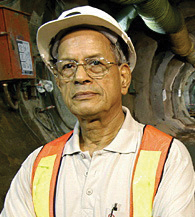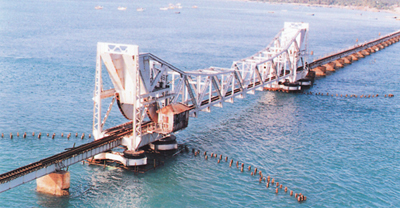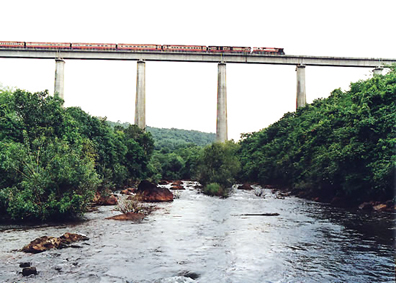
E. Sreedharan.
|
December 31, 2011: India had just lost the Boxing Day Test match, with a day to spare. Star News was deciding who was the 'Match ka Mujrim'. Others were wondering when Sachin would finally score that 100th hundred. If an alien visited India around that time and switched on the television, he/she would have thought our world started and ended with cricket. Pretty sad, considering an event that slipped completely under our radar.
Elattuvalapil Sreedharan, affectionately called the 'Metro Man of India', bid adieu to his 56-year-long career of creating 21st Century monuments. His exit was a reflection of how he lived: simple, elegant and completely inconspicuous.
Just pause for a moment and think.
56 successive years, in a single job, without a break. Doing path-breaking work. And no one in the media was paying tribute to this great man. They were not even talking about it. All they had was a silly ticker at the bottom of the screen, that said 'Dr Sreedharan Retires'. No ten thousand word articles, no special Sreedharan shows, nothing. It was like it didn't even happen.
The fundamental question is: Why?
Is it simply because Sreedharan is not your quintessential Indian Success Story?
I mean, he is not a IITian, nor is he from an IIM. He is not from a minority community. He did not surmount racial and casteist prejudices imposed by society. He was not an underprivileged person who attained success. He is neither an actor nor a singer, nor a cricketer.
He is just a simple middle class Indian, who went about his job. In other words, he does not fall under any bracket that our media terms as an 'Indian Success Story'. And according to the media, not an 'Indian Success Story' means 'No tribute'. And this in a day when Chetan Bhagat will get a glowing biography on his life and times the day he finally decides to stop writing. OK, sod the media. They have TRPs and paying news customers to take care of. But what about the Government? They don't have to answer to anybody. And this guy dedicated his entire life to them. At least they can do something. But, No.
The travesty is all the more acute if you consider what Sreedharan has done for millions in our nation.
* * *
South India happens to be a favourite holiday spot for various cyclones brewing in the Bay of Bengal. This geographical part of India has been hit by so many cyclones that nowadays meteorologists have run out of names.
One such cyclone hit the coastal town of Rameswaram on December 22, 1964. And it was a deadly one. Not so long ago, south of Rameswaram, there used to be a bustling town called Dhanushkodi. It had its own post office, customs office and even a Railway Station. My bet is most of you wouldn't have heard about it. Why? Because on that fateful night, the Indian Ocean swallowed the entire town. More than 2000 people were killed. The ocean even ensured that a passenger train which was beginning its last journey of the day at 11.15 p.m. made its last journey ever.
So where does Sreedharan come into all of this?
As a sideshow, the cyclone destroyed the Pamban Bridge, the only bridge connecting Rameswaram to mainland India. And this meant Rameswaram was completely isolated. Something had to be done, and fast.

The Pamban bridge after restoration.
|
At that time, Sreedharan was a Deputy Engineer in the Southern Railway. And this piece of wreck was in his territory. Indian Railways gave Sreedharan six months to restore connectivity to Rameswaram. Which was asking a lot considering what Sreedharan had to convert to use. Sreedharan finished the job in forty-six days to put back into full operation the bridge which was India's longest sea bridge (2.3 km) for 96 years, till the Bandra-Worli Sea Link was inaugurated in 2008.
Packing his bags for his next assignment, he set off to Calcutta, where he became the chief designer of the Calcutta Metro. And then, moving on from railways, he took charge of India's largest shipbuilding company, Cochin Shipyard. There he designed, built and commissioned India's first indigenously built merchant vessel, the Rani Padmini, in 1981.
After building everything from trains to ships, Sreedharan, according to Government rules, had to retire in 1990 when he completed 60 years of age. But, when you are Sreedharan, you don't have the plebeian privilege of retirement.
He was asked to go to Mumbai, to take charge of what was then deemed to be India's toughest project since Independence. It involved burrowing through basalt mountains, spanning kilometres-long marshes and rivers and taking railways to a place where even the British thought it was impossible. This region was the Western Ghats of Maharashtra, the Konkan.
* * *
The railway babus simply called this herculean venture Konkan Railway. Naming things is not really their forte. And slapped it with a pathetic logo.
This is what Sreedharan had to do: Lay 760 kms of railway track, through a terrain that had mountains, rivers, and forests infested with snakes and where various tropical fevers were commonplace.
And to do that, Sreedharan had to:
- Acquire 5000 hectares of land from 42,000 assorted land owners.
- Build 2000 bridges, both major and minor, across marshes, swamps, rivers and backwaters.
- Blast 92 tunnels, totalling 83 km in length, through basalt, nature's adamantium, and soft soil, nature's china clay.
And then came the most difficult task in the Indian index of difficult tasks. Dealing and negotiating with Chief Ministers, Home Ministers, other Ministers and their chelas of four different states.
And to complete all these tasks, Sreedharan was given eight years.
Sreedharan, supposedly retired and who qualified for the Indian Railways' senior citizen quota, finished the job in seven years. Konkan Railway to me is the second biggest achievement of Independent India, the first being India remaining India. The Konkan Railway ensured that:
- For the first time ever, the three largest ports on the Indian coast, Mumbai, Karwar and Mangalore, have a direct connection.
- Travel time from the southern states to the north has been reduced by upto 40 per cent. The old Nethravathi Express used to take 38 hours to travel from Trivandrum to Mumbai. Now, thanks to Sreedharan and the Konkan Railway, the same train takes 22 hours. A 16-hour reduction in travel time. Indeed a 16-18 hour reduction in travel times of all trains going from Kerala, Karnataka, Goa to the North. ALL trains. Try measuring the impact. The sheer number of architectural impossibilities, overcome by Sreedharan and his team making this wild dream a reality, is mind-boggling. One thing that encapsulates all that was achieved is the viaduct over the Panvel Nadi.

The viaduct over Panvel Nadi.
|
The Nadi is a marsh between two hills and, to traverse it, the train has to travel across a viaduct which is as tall as the Qutub Minar, over a marsh between two hills. You will see this wonder of Modern India immediately after Ratnagiri on the Konkan Railway. In a 15-kilometre stretch between Ratnagiri and Nivasar are three tunnels and five viaducts; the third viaduct is the Panvel Nadi viaduct, immediately after the first tunnel.
* * *
Sreedharan, though, never had the chance to taste his success. In December 1997, one year before the Konkan Railway was thrown open to traffic, he was shunted to New Delhi to head a new organisation. It was created to find a viable solution to the traffic woes of the aam aadmi in the national capital. This was the Delhi Metro Railway Corporation.
Of all the railway systems in the world, building a metro is the most difficult in the world. Most difficult becomes impossible when you have to build under and over a megapolis.
Delhi Metro was not India's first metro. Calcutta has that honour. But Calcutta's took 22 years to build a total length of 16.75 km. The Calcutta Metro suffered from debilitating shortages of funds, labour and everything else. And it was harried by the parent, the Indian Railways, every step of the way. If the Calcutta Metro was any indicator, the 168 km long Delhi Metro would have been beset with shortages, harassed by the Railways and would have been completed in A.D. 2083.
When Sreedharan started off, he put in place some things that had never before been done in the history of Indian mega construction projects, like:
He appointed himself as the judge, jury and the executioner as far as the Delhi Metro was concerned. No external influences were tolerated. There have been stories of people who walked in with the traditional M.P. recommendation letter, and who walked out of his office with the paper in two different hands.
After giving himself the power, he changed the tendering process, upside down. In a country where opening a single tender took, on an average, six to nine months, he got the job done in 19 days.
When confronted with the standard Government 'I am short of money' rigmarole, Sreedharan did what any sensible government servant would do. He simply cut out the Government from funding. He single-handedly went and got a loan of US$ 5 billion sanctioned from the Japanese Bank of International Cooperation to fund the Metro. With 60 per cent of the necessary finance secured, Government shut up and put up the remaining cash.
He then hired top international consultants from an assortment of countries to cover for the lack of local talent, to supervise and execute the project.
For the first time in the history of India, the entire Delhi bureaucratic circle was completely circumvented. That too by a 74-year-old from Kerala.
As a result, Phase One of the 5 billion dollar Metro was completed three years before schedule, entirely within the initially stipulated budget. And there was not even a single shard of corruption. In India, that is the closest we can get to walking on water.
Today, the Delhi Metro is complete and, for the first time, Dilliwalas are enjoying the benefits of a full-fledged suburban rail system that has a punctuality factor of over 99 per cent.
* * *
Every Indian city worth its salt now wanted its own metro and Sreedharan as its consultant. One such city was Hyderabad. And the company executing that Metro was a company called MAYTAS Infrastructure. In September 2008, Sreedharan gave his views as a consultant. He smelt a rat and feared a big political and local scandal in the future. The Planning Commission, as usual did not pay heed to that report. In fact, it chastised Sreedharan for not backing up his allegations with necessary proof. Three months later the scandal broke. Sreedharan had predicted that the Company and its parent were in trouble three months before the world knew it.
* * *
I don't know how the Bharat Ratna nomination thing works. But I believe you stand a chance if you have done something extraordinarily good for the country. Now tell me, what has Sreedharan not done for millions in the country?
|